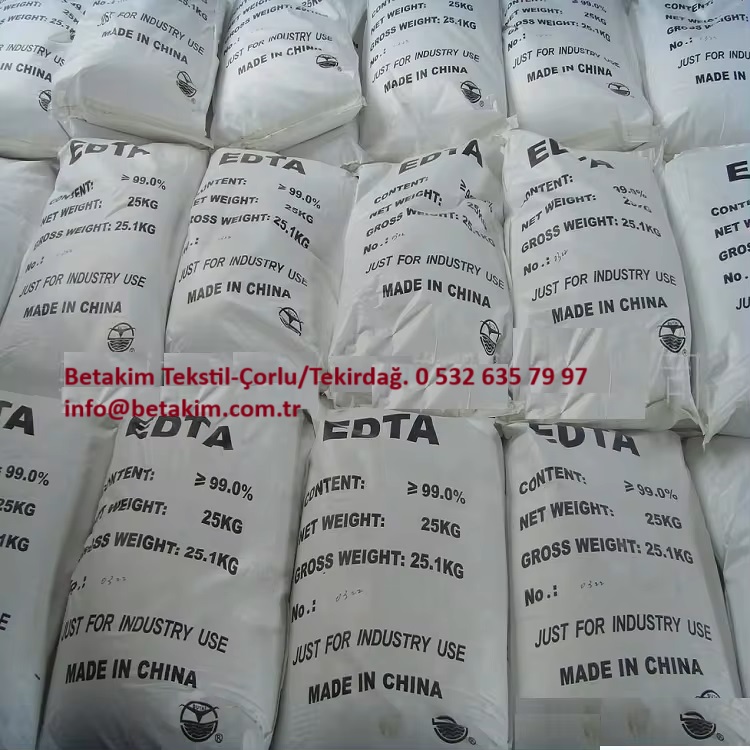We unleash your business potential by maximize the business innovation.
Send EmailEDTA, Ethylenediamine Tetraacetic Acid, Chelating Agent, 60-00-4
Molecular Formula (Edta); C10H16N2O8
Molecular Weight; 292.24 g/mol
Chemical Name; Ethylenediamine Tetraacetic Acid
Cas Number; 60-00-4
It is a type of polyamino carboxylic acid. More than one -COOH group is attached to its structure. Therefore, it is in the polycarboxylic acid group. Since -NH2 is attached to its structure, they take the amino suffix. Therefore, it is grouped as polyamino carboxylic acid. EDTA is the abbreviation of ethylenediamine tetraacetic acid. It is a colorless and crystalline solid.
It has been determined as a molecular biology class. And it is very suitable for molecular biology applications.
It has a very good affinity for some metal ions. With this feature, it can make very good chelating. Ethylene Diamine Tetra Acetic Acid is the chemical with the best properties as an anticoagulant agent.
Other Names of EDTA are as follows;
Ethylenediamine Tetraacetic Acid
Chelating Agent
Sequestering Agent
60-00-4
Na2
Na4
What are its physical and chemical properties?
Its melting point is 237 °C.
Its boiling point is 100 °C.
Its density is 0.86 g/cm3.
Its storage temperature is 2-8 °C.
EDTA solubility is 100 mg/mlt in 3M NaOH solution. However, it dissolves in water at 0.5 g/L (25 °C). In other words, when we look at it, it is slightly soluble in water.
It has a crystalline structure in appearance. It is almost white in color.
It is a stable chemical under normal conditions. It is insoluble in copper, copper alloys, nickel, aluminum, strong oxidizing agents and strong bases.
Areas of Use:
EDTA (Ethylenediamine Tetraacetic Acid) potassium and sodium salts are widely used in routine Hematology (blood science) determinations since they do not cause damage to the cellular components of the blood.
It is used as a chelating agent in magnesium-containing cleaning compounds.
It is among the raw materials required to produce solvent-containing detergents. It is used as a chelating agent.
Since it forms stable complexes with most metal ions, Edta is used in the treatment of farm animals in lead and heavy metal poisoning.
It is used as a component of household detergents, cosmetics, medicines and foodstuffs.
Its main function is to interact with metal ions and form complex structures.
Cleaning agents are used in the aviation sector to prevent the precipitation of heavy metals that can cause sedimentation and coating in container pipes and nozzles. Edta is used in the manufacture of these cleaning agents.
Phosphates are balanced in alkaline degreasing fleets and are used to make calcium soap clump.
This application is carried out with EDTA by intensifying the cleaning effect and damaging metal surfaces.
It is used in milk and beverage production.
In the photochemical industry, the processes in the combination of oxidation and fixation of metallic silver (removal of silver ions by complexing) are carried out by applying EDTA before bleaching.
It is used in the dairy industry to prevent the oxidation of metal ions. In this way, the shelf life of milk and dairy products is extended.
In the textile industry, it is used in textile coatings to support cross-linking of cellulose molecules (to produce easy-care fabrics), to support oxidative bleaching processes and to prevent catalytic damage that may occur in the fibers.
In the paper industry, bleaching agents are used to remove the remaining lignin from cellulose fibers. And the brightness is increased. It is also used in paper mills. If the bleaching agent Hydrogen Peroxide is used, heavy metals such as manganese can break down the peroxide. The reason for using Ethylene Diamine Tetra Acetic Acid is to create a chelated structure. Because ethylene diamine tetra acetic acid does not stick to paper like manganese, and then all of the EDTA goes to the sewage system as waste.
In the metal coating sector, it is used to coat copper as a result of the precipitation of copper complex compounds on wooden boards by catalytic reduction method. In this application, the production of printed circuit boards is carried out with the help of EDTA.
It is used to prevent the formation of calcium and magnesium stones in water treatment systems. In water treatment systems, it is used as an additive to prevent and clean internal deposits in the boilers of the waters feeding the system.
It is used in the production of Styrene Butadiene Elastomer produced by emulsion polymerization. The purpose of use here is to be a sequestration agent for Fe(II)/Fe(III) ions in the initiator system in production.
It is used as a good cleaning agent in oil production platforms. It must be added continuously with certain dosages.
EDTA is used to remove sulfur fumes in coal power plants and waste incineration plants. It has an iron chelating feature when used with 70% sorbitol and sodium hydroxide for the catalytic removal of hydrogen sulfide.
It is used to prevent color loss and mold formation in soaps and increases the cleaning effect of the soap.
Potassium Sorbate and Sorbic Acid can be used as preservatives in food, cosmetic and pharmaceutical applications. If Potassium Sorbate is used, color deterioration may occur. This compound is used as a complex compound to prevent this.
It is used as a corrosion inhibitor together with Hydroxylamone Sulfate (Hydroxylamine Sulphate) in crystallization units made of stainless steel. It is an important component for solving such corrosion problems.

